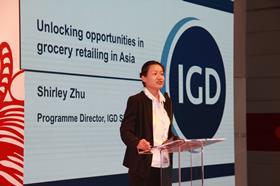
Growth of modern grocery retail is set to continue across Asia but expansion will vary across markets as retailers adapt to regional and national consumer trends and needs, delegates at Asiafruit Congress heard today (5 September).
Retail development is split across four stages including embryonic (Vietnam and India); emerging giants (the Philippines and Indonesia); modern shapers (China, Malaysia and Thailand); multichannel trendsetters (Japan, Taiwan and South Korea), said Shirley Zhu of IGD Singapore.
She said that as markets develop, suppliers can expect more collaboration with retailers, but specific models and consumer trends vary significantly according to the stage of retail development.
“In the embryonic markets, you can expect lots of new market entrants from both domestic and imported players,” she explained. “The emerging giants include Indonesia and the Philippines and in these markets we expect stronger local and regional players. Logistics can also be a huge problem as both markets are made up of thousands of islands.”
In the more developed retail markets, such as Thailand, Japan, China and Taiwan, retailers have stopped “land-grabbing”, said Zhu, and instead they are now working to understand their customers, trial new åformats and develop an identity.
“One of the themes we have seen is big stores are utilising their space better,” she continued. “Tesco Lotus Extra in Thailand is repurposing space and franchising out to other businesses, and that has been quite successful.
“As the store space gets smaller, they will take only their customers favourite products, or the one that is generating the most revenue. This year alone, Tesco Lotus is cutting about 50,000 sq m of store space.
“Larger stores are also trying to drive footfall through their destination products, these are the products they are known for, whether that’s fresh or beauty or wines,” she continued. “As suppliers, it is your job to think what is the destination category that your retailer is building and how can you be part of it.”
In China, Carrefour is looking at building a store that is an entertainment space, combining a supermarket with restaurants, cinemas and other retail services. “The goal is to attract the shoppers into their stores. With a growing online competition, they really need to keep shoppers in store and engaged,” Zhu added.
The growth rate in Asian retail is similar to Latin America, said Zhu, at around six per cent year on year. By 2021, Asia will be bigger than Europe and North America combined, retaining its crown as the largest global retail market.
Asian grocery retail sales reached USD $3,011 billion in 2016 with China as the biggest market in the region, followed by India, Japan and Indonesia.
The fastest growing channels include e-commerce, convenience and imported fruit, as well as the crossover of foodservice into retail, and on-site preparation of products such as bakery and noodles.



